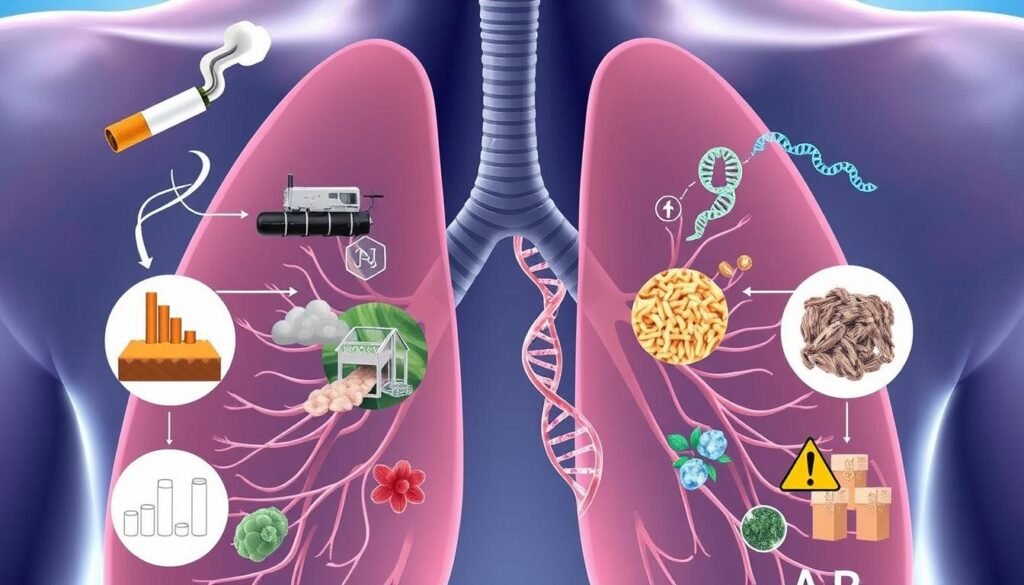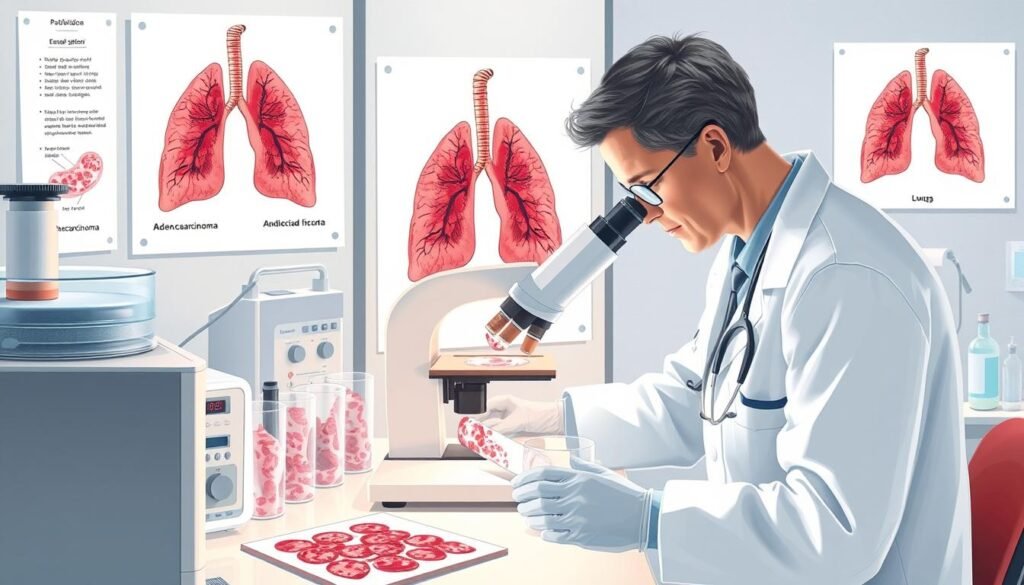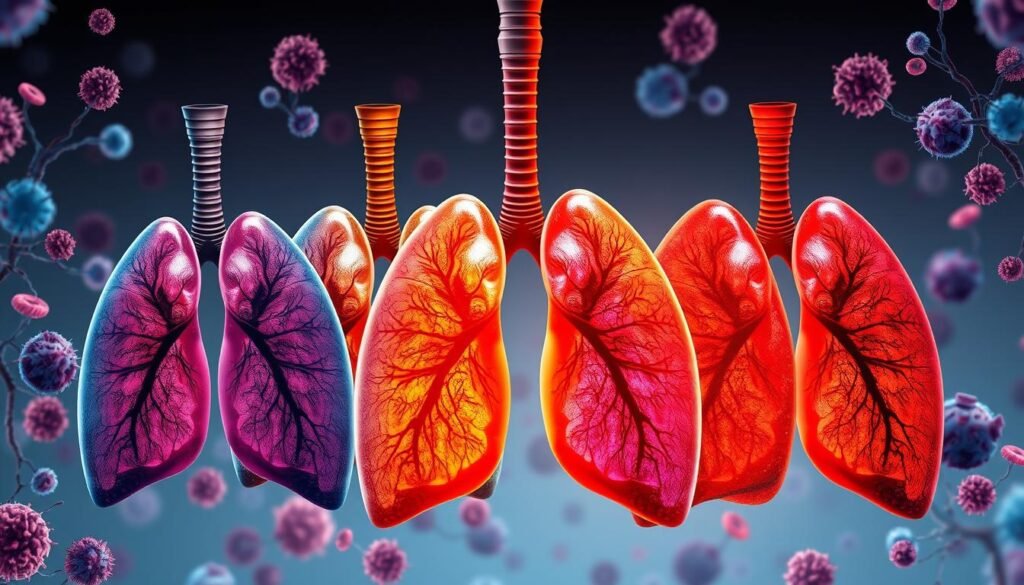Did you know adenocarcinoma makes up almost 40 percent of all non-small cell lung cancers (NSCLC)? This lung cancer is especially aggressive. It’s most common in nonsmokers and tends to affect more women than men. Knowing about adenocarcinoma is crucial because it affects treatment choices and results for patients.
This guide will talk about what adenocarcinoma lung cancer is, its symptoms, causes, and how it’s diagnosed. We’ll also look at treatments, survival rates, and what the future holds. Research like what’s found at PMC helps everyone understand more about this disease. This info is key for patients, their families, and doctors to manage this type of lung cancer.
Key Takeaways
- Adenocarcinoma lung cancer is the most common type of NSCLC.
- It is more prevalent among women and younger individuals.
- Smoking is linked to about 80% of lung cancer deaths.
- Common symptoms include persistent cough, shortness of breath, and fatigue.
- Various diagnostic tests are critical for effective treatment planning.
- Understanding lung cancer survival rates aids in better prognostic assessments.
- Innovative treatment options include surgery, chemotherapy, radiation, and targeted therapies.
What is Adenocarcinoma Lung Cancer?
Adenocarcinoma lung cancer is a major part of lung cancer cases. It is a type of non-small cell lung cancer (NSCLC), making up about 40% of all lung cancers. It starts in the alveolar cells that help with the exchange of gases in the lungs. Compared to other lung cancers, adenocarcinoma usually grows more slowly.
Definition and Overview
Adenocarcinoma Lung Cancer is mainly found in the outer areas of the lungs. This distinguishes it from types like squamous cell carcinoma. It is more common in women and people who have never smoked.
Differences from Other Lung Cancer Types
Non-small cell lung cancer and small cell lung cancer are the main lung cancer types, with adenocarcinoma being a type of NSCLC. Around 15% to 20% of lung cancers are small cell lung cancer, mostly linked to smoking. However, adenocarcinoma mainly affects non-smokers, marking a key difference. Other NSCLC subtypes include squamous cell carcinoma, large cell carcinoma, and adenosquamous carcinoma, all with unique features.
Prevalence and Demographics
In the United States, adenocarcinoma is the most commonly found lung cancer. It mainly targets younger people, ages 20 to 46. Women and those who have not smoked are especially affected. This information helps identify those at high risk and develop prevention methods.
Lung Cancer Symptoms
Spotting lung cancer symptoms early is key to effective treatment and better health management. Adenocarcinoma, a common lung cancer type, shows symptoms that are not always obvious. Knowing these signs can push for quicker doctor visits.
Common Symptoms of Adenocarcinoma
Early on, adenocarcinoma symptoms might not show, making early diagnosis hard. People often report:
- Persistent cough that doesn’t improve
- Shortness of breath or difficulty breathing
- Chest pain, especially during deeper breaths
- Loss of appetite accompanied by unexplained weight loss
- Fatigue that doesn’t resolve with rest
- Coughing up blood, which can be alarming
Knowing these symptoms increases awareness. Early detection is vital for better treatment chances and outcomes.
Symptoms vs. Other Respiratory Conditions
Common symptoms of adenocarcinoma can look a lot like other respiratory conditions, such as COPD. Telling them apart is crucial to avoid misdiagnosis. Both might show a chronic cough and breathing troubles. Not knowing the difference can stall needed treatments.
It’s critical for people at risk, like smokers or those with lung cancer in the family, to recognize these distinctions. To understand how lung cancer signs and respiratory conditions compare, more info is available here.
Adenocarcinoma Causes and Risk Factors
Adenocarcinoma is a common lung cancer type. Many risk factors play a role in its development. It is crucial to know these causes to help prevent and detect it early. Even though smoking is a key factor, it’s not the only risk. Many people who get this cancer have never smoked.
Smoking and Environmental Factors
About 80% of lung cancer deaths are due to smoking. The chemicals in cigarettes damage cells and increase adenocarcinoma risk. Besides smoking, secondhand smoke, radon gas, and asbestos also pose dangers. Being around these elements requires caution and safety measures.
Genetic Factors Influencing Risk
Our genes play a big role in lung cancer risk. Changes in certain genes raise the chances of getting adenocarcinoma. If your family has had this cancer, your risk may be higher. This shows how closely genetics and cancer risk are linked.
Role of Secondhand Smoke and Other Exposures
Secondhand smoke is also a big risk for lung cancer. It affects not only smokers but also non-smokers around them. Pollution and job-related dangers can also hurt our lungs. We need efforts to reduce the risk from environmental factors. For more details, click here.

Adenocarcinoma Diagnosis
Diagnosing adenocarcinoma means taking several diagnostic tests to find cancerous cells in the lungs. First, doctors may use chest X-rays to spot unusual areas. Yet, a CT scan is often better. It gives more info on the tumor’s size, shape, and place. MRI scans are vital, too. They check if the lung cancer has spread to important organs, like the brain and liver.
Diagnostic Tests for Lung Cancer
Doctors use several key methods to diagnose adenocarcinoma:
- CT scans: They’re crucial for seeing lung tumors and checking for swollen lymph nodes.
- MRI scans: These scans help figure out where the cancer has spread.
- Biopsies: Through needle biopsies, like fine needle aspiration and core needle biopsies, doctors gather tissue for testing.
- PET scans: These scans are important for staging cancer by finding its exact location and how far it’s spread.
- Sputum cytology: By examining mucus samples, doctors can spot cancer cells. This is especially true for squamous cell carcinomas.
The Importance of Early Detection
Spotting lung cancer early is crucial for better treatment chances. Catching adenocarcinoma early makes it easier to deal with than when it’s more advanced. Talking regularly with healthcare experts boosts the odds of noticing symptoms early. This leads to getting the right tests on time.

Lung Cancer Stages
The way lung cancer is staged is key in figuring out how to treat it and knowing how it might progress. The TNM staging system looks at three main things: tumor size (T), if lymph nodes are involved (N), and if there’s metastasis (M). This system helps doctors put cancer into specific stages, especially for a type called adenocarcinoma.
Understanding the TNM Staging System
The TNM system is crucial for lung cancer stages. It sorts tumors by:
- T (Tumor): How big the main tumor is and where it’s located.
- N (Node): If lymph nodes nearby are affected.
- M (Metastasis): If the cancer has spread far.
Stages go from 0, which means the cancer hasn’t grown beyond where it started, to IV, which means it has spread to distant places. Knowing the exact stage is vital for planning the best treatment. For details on each stage, check out staging lung cancer.
Stage Descriptions of Lung Adenocarcinoma
For lung adenocarcinoma, there are specific sub-stages:
| Stage | Description |
|---|---|
| Stage 0 | Cancer is just in the lung’s surface layers. |
| Stage I | This stage is split into 1A and 1B. 1A covers smaller tumors and goes from 1A1 to 1A3. 1B is for bigger tumors or ones affecting nearby parts. |
| Stage II | This includes IIA and IIB, based on tumor size and lymph nodes, but there’s no spread yet. |
| Stage III | This stage is divided into IIIA, IIIB, or IIIC, showing larger tumors or more lymph node involvement. |
| Stage IV | This means the cancer has spread to other body parts. |

Knowing about these sub-stages helps in figuring out treatment. Each stage affects choices like surgery, chemotherapy, and more. This ensures care is customized for each patient.
Lung Cancer Treatment Options
Treating lung adenocarcinoma depends a lot on the cancer stage and the patient’s health. Doctors use a mix of treatments tailored for each person. Choices can include surgery, chemo, radiation, and targeted therapies. They pick treatments based on the cancer and the patient’s health.
Surgery: Types and Procedures
Surgery is a key option, especially early on. It might be removing part of the lung or all of it. These steps can help people live longer if the cancer is found early. The success of surgery often depends on careful preparation.
Chemotherapy and Radiation Therapy
Chemo is crucial for advanced lung cancer and is often paired with radiation. These methods aim to destroy cancer cells or shrink tumors. Together, chemo and radiation can be more effective for tough lung cancers.
Targeted Therapies and Immunotherapy
Targeted treatments attack certain genes in cancer cells. They’re changing how doctors handle lung cancer, especially for some patients. Immunotherapy is another area being explored. It boosts the body’s defense against cancer. Ongoing research offers new possibilities. For the latest treatments, check out top lung cancer oncologists.
| Treatment Type | Description | Common Use |
|---|---|---|
| Surgery | Removal of cancerous lung tissue | Early-stage lung cancer |
| Chemotherapy | Use of drugs to kill cancer cells | Advanced stages |
| Radiation Therapy | Focused radiation to target tumors | Advanced stages or post-surgery |
| Targeted Therapies | Drugs tailored to specific genetic targets | Based on genetic profiling |
| Immunotherapy | Boosts the body’s immune response | Varies, often for advanced cancer |
Lung Cancer Survival Rates
Lung cancer survival rates depend on several factors. These include cancer stage at diagnosis and patient health. Knowing these can set realistic expectations and underscore early detection’s importance.
Factors Influencing Prognosis
Several factors influencing prognosis in lung cancer include:
- Early-stage diagnosis generally leads to better outcomes.
- The patient’s health and age matter.
- The tumor’s genetics influence treatment response.
- How well the cancer responds to treatment like chemo and radiation.
- Lung cancer types, like adenocarcinoma, grow slower than others.
Statistical Overview of Survival Rates by Stage
Statistics show big differences based on disease stage:
| Stage | 5-Year Survival Rate |
|---|---|
| Stage I | 65% |
| Stage II | 40% |
| Stage III | 15% |
| Stage IV | 5% |
Generally, fewer than 20% of lung cancer patients survive five years after diagnosis. In the U.S., the overall 5-year survival rate for non-small-cell lung cancer is about 23%. These statistics help patients grasp their situation and motivate them to actively manage their health.
Adenocarcinoma Lung Cancer Prognosis
The outlook for someone with adenocarcinoma lung cancer can vary a lot. It depends on when it’s found and the treatments used. Knowing how impact of early detection can change things is key for patients.
Impact of Early Detection on Prognosis
Finding the cancer early is critical to improve chances. If caught early, patients often have better outcomes. They can use less harsh treatments. For example, if there’s just one tumor, the chance of living five more years is 98%. This shows why regular checks and paying attention to new symptoms are important.
Long-term Survival and Quality of Life Considerations
More people are living longer with adenocarcinoma because of new treatments. Yet, survival rates vary with each stage of cancer. For early-stage disease, the five-year survival is around 65%. But for stage IV, it drops to 9%. Even with better survival, treatments can affect how patients feel and live. This makes supportive care and talks about treatment impacts vital.
Conclusion
It’s important for patients and their caregivers to understand lung adenocarcinoma. Knowing about symptoms, causes, and how it’s diagnosed helps. It enables them to make smart choices and work closely with their doctors.
Treatment options for adenocarcinoma lung cancer have gotten better, especially with targeted therapies. These therapies are tailor-made for specific types. So, if a patient’s cancer is tested for EGFR mutations, they may respond well to these treatments. This means a more personalized approach to fighting cancer.
Research in cancer treatment is always moving forward. Meanwhile, having good support and advice is key in dealing with lung cancer. Staying proactive and keeping in touch with healthcare teams helps patients. It improves their journey through cancer treatment.